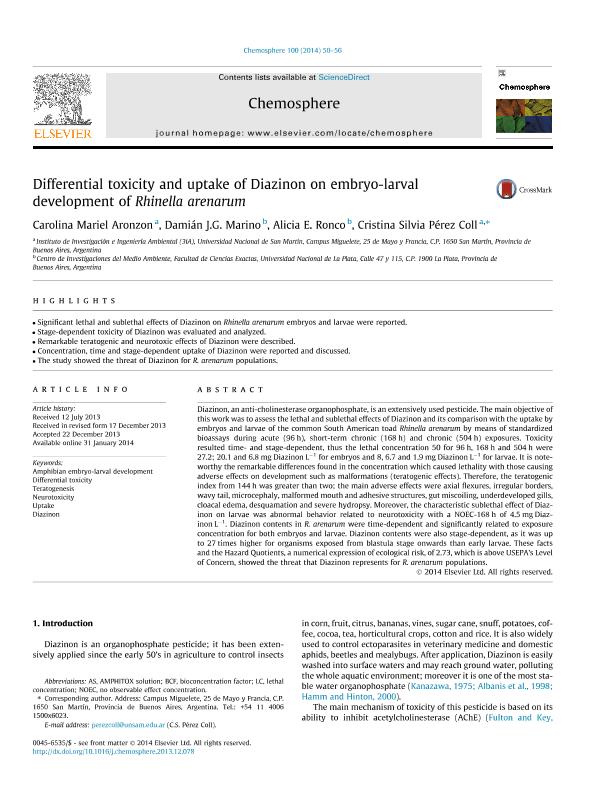Mostrar el registro sencillo del ítem
dc.contributor.author
Aronzon, Carolina Mariel

dc.contributor.author
Marino, Damian Jose Gabriel

dc.contributor.author
Ronco, Alicia Estela

dc.contributor.author
Perez Coll, Cristina Silvia

dc.date.available
2017-12-20T20:54:12Z
dc.date.issued
2014-02
dc.identifier.citation
Perez Coll, Cristina Silvia; Ronco, Alicia Estela; Marino, Damian Jose Gabriel; Aronzon, Carolina Mariel; Differential toxicity and uptake of diazinon on embryo-larval development of Rhinella arenarum; Elsevier; Chemosphere; 100; 2-2014; 50-56
dc.identifier.issn
0045-6535
dc.identifier.uri
http://hdl.handle.net/11336/31176
dc.description.abstract
Diazinon, an anti-cholinesterase organophosphate, is an extensively used pesticide. The main objective of this work was to assess the lethal and sublethal effects of Diazinon and its comparison with the uptake by embryos and larvae of the common South American toad Rhinella arenarum by means of standardized bioassays during acute (96 h), short-term chronic (168 h) and chronic (504 h) exposures. Toxicity resulted time- and stage-dependent, thus the lethal concentration 50 for 96 h, 168 h and 504 h were 27.2; 20.1 and 6.8 mg Diazinon L−1 for embryos and 8, 6.7 and 1.9 mg Diazinon L−1 for larvae. It is noteworthy the remarkable differences found in the concentration which caused lethality with those causing adverse effects on development such as malformations (teratogenic effects). Therefore, the teratogenic index from 144 h was greater than two; the main adverse effects were axial flexures, irregular borders, wavy tail, microcephaly, malformed mouth and adhesive structures, gut miscoiling, underdeveloped gills, cloacal edema, desquamation and severe hydropsy. Moreover, the characteristic sublethal effect of Diazinon on larvae was abnormal behavior related to neurotoxicity with a NOEC-168 h of 4.5 mg Diazinon L−1. Diazinon contents in R. arenarum were time-dependent and significantly related to exposure concentration for both embryos and larvae. Diazinon contents were also stage-dependent, as it was up to 27 times higher for organisms exposed from blastula stage onwards than early larvae. These facts and the Hazard Quotients, a numerical expression of ecological risk, of 2.73, which is above USEPA’s Level of Concern, showed the threat that Diazinon represents for R. arenarum populations.
dc.format
application/pdf
dc.language.iso
eng
dc.publisher
Elsevier

dc.rights
info:eu-repo/semantics/openAccess
dc.rights.uri
https://creativecommons.org/licenses/by-nc-nd/2.5/ar/
dc.subject
Amphibian Embryo-Larval Development
dc.subject
Teratogenesis
dc.subject
Neurotoxicity
dc.title
Differential toxicity and uptake of diazinon on embryo-larval development of Rhinella arenarum
dc.type
info:eu-repo/semantics/article
dc.type
info:ar-repo/semantics/artículo
dc.type
info:eu-repo/semantics/publishedVersion
dc.date.updated
2017-12-12T18:25:12Z
dc.journal.volume
100
dc.journal.pagination
50-56
dc.journal.pais
Países Bajos

dc.journal.ciudad
Amsterdam
dc.description.fil
Fil: Aronzon, Carolina Mariel. Universidad Nacional de San Martín. Instituto de Investigación e Ingeniería Ambiental; Argentina. Consejo Nacional de Investigaciones Científicas y Técnicas; Argentina
dc.description.fil
Fil: Marino, Damian Jose Gabriel. Universidad Nacional de La Plata. Facultad de Ciencias Exactas; Argentina. Consejo Nacional de Investigaciones Científicas y Técnicas. Centro Científico Tecnológico Conicet - La Plata; Argentina
dc.description.fil
Fil: Ronco, Alicia Estela. Consejo Nacional de Investigaciones Científicas y Técnicas. Centro Científico Tecnológico Conicet - La Plata; Argentina. Universidad Nacional de La Plata. Facultad de Ciencias Exactas; Argentina
dc.description.fil
Fil: Perez Coll, Cristina Silvia. Consejo Nacional de Investigaciones Científicas y Técnicas; Argentina. Universidad Nacional de San Martín. Instituto de Investigación e Ingeniería Ambiental; Argentina
dc.journal.title
Chemosphere

dc.relation.alternativeid
info:eu-repo/semantics/altIdentifier/url/https://www.sciencedirect.com/science/article/pii/S0045653514000150
dc.relation.alternativeid
info:eu-repo/semantics/altIdentifier/doi/http://dx.doi.org/10.1016/j.chemosphere.2013.12.078
Archivos asociados
